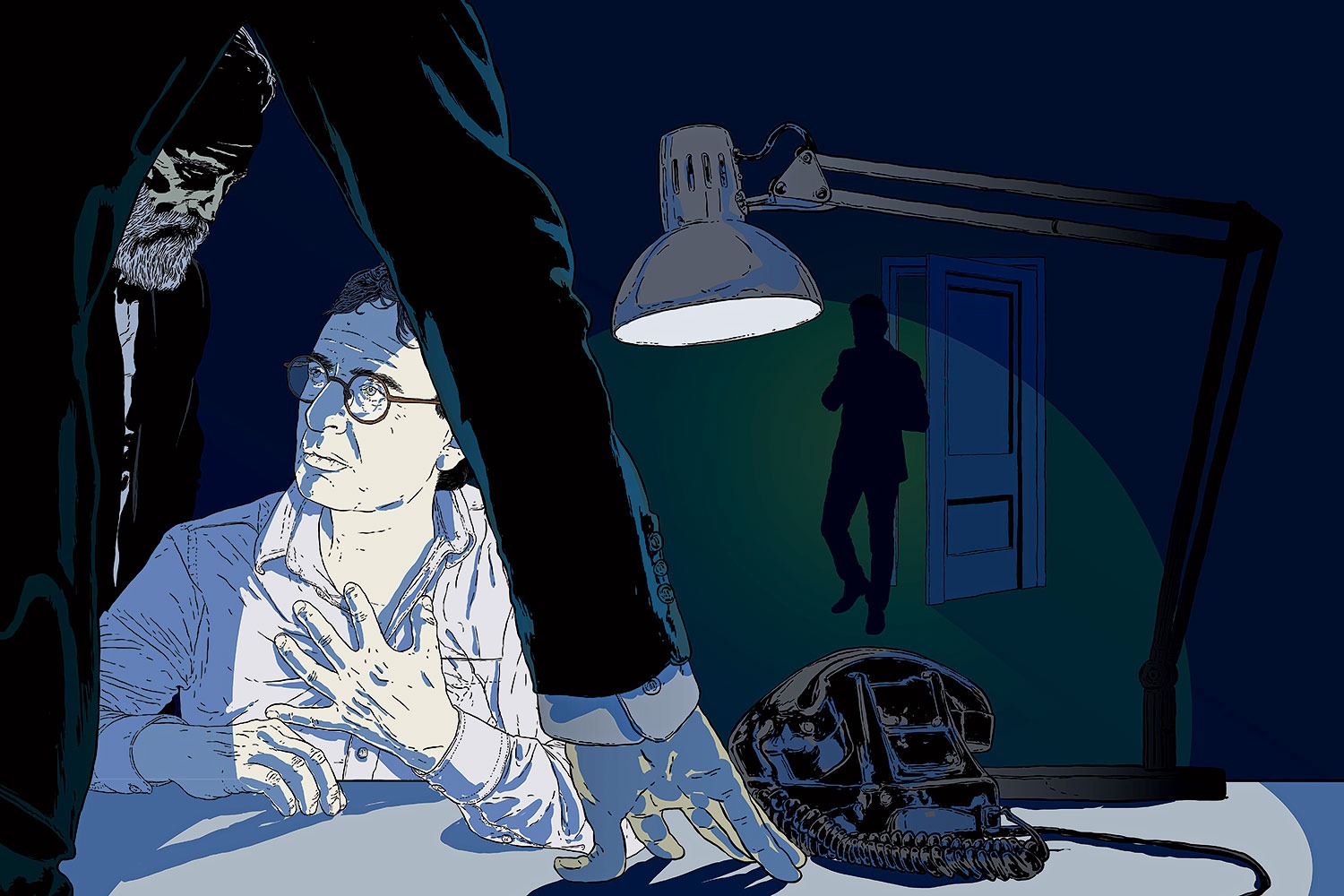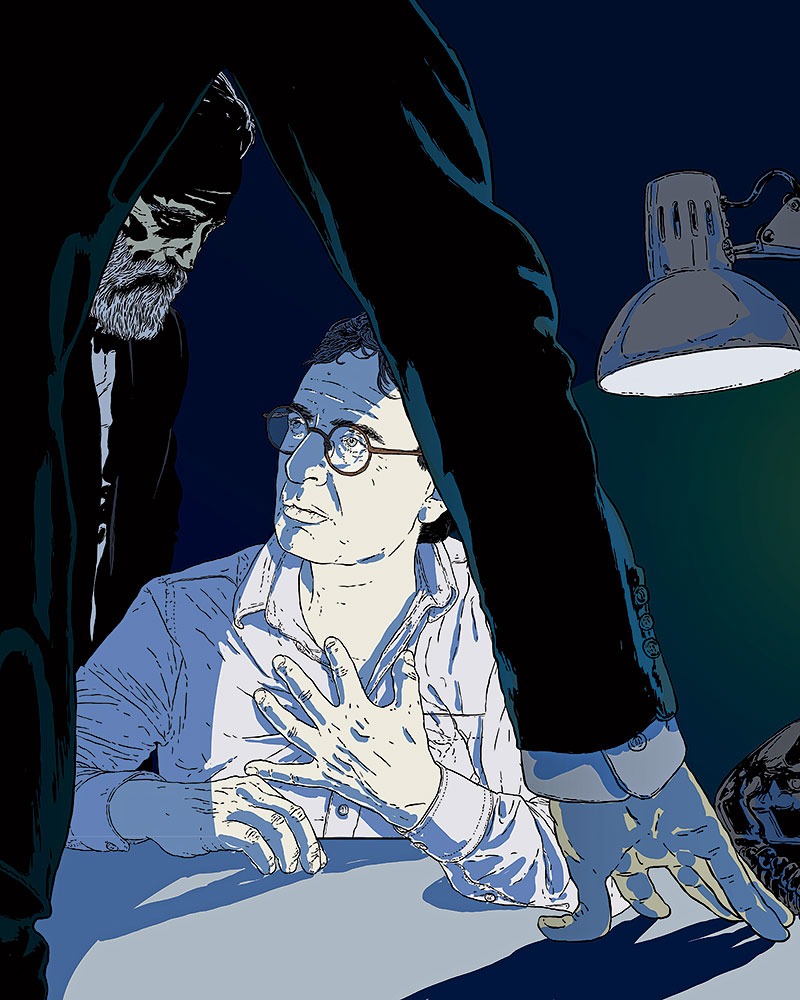 bbas Alizadeh stepped off the plane in Tehran exhausted and a bit anxious. He had been traveling for 19 hours, flying first from O’Hare to Doha, Qatar, then on to Iran. It was May 2021, and the University of Chicago professor, one of the world’s foremost experts on prehistoric and ancient Iranian archaeology, was there to study a collection of potsherds — fragments of clay vessels — hoping that they might offer insights about early apprentice potters.
bbas Alizadeh stepped off the plane in Tehran exhausted and a bit anxious. He had been traveling for 19 hours, flying first from O’Hare to Doha, Qatar, then on to Iran. It was May 2021, and the University of Chicago professor, one of the world’s foremost experts on prehistoric and ancient Iranian archaeology, was there to study a collection of potsherds — fragments of clay vessels — hoping that they might offer insights about early apprentice potters.
At Imam Khomeini International Airport, named after the late leader of the country’s theocratic government, armed guards and customs officials are ready to detain anyone suspected of bringing illicit items into the country — alcohol, women’s or pornographic magazines, pork — or bearing a visa stamp from Iran’s perennial enemy, Israel. Alizadeh, then 70, was, in fact, carrying contraband: The Iranian-born professor had a pack of frozen kielbasas from Jewel-Osco furtively tucked away in his baggage. A gift for his family. You can find almost anything you want in Iran, if you have enough money. Polish sausages, though? These were not easy to get your hands on.
Alizadeh wasn’t too worried. Having returned to his home country many times in the years after the Islamic Revolution of 1979 — sometimes on archaeological digs, other times to visit family members — he knew that if he was caught with the sausages, the worst that would happen was that authorities would confiscate them and give him a stern talking-to.
Yet he still held his breath going through customs. The professor was guarding an immense and dangerous secret: Throughout his career, he had spent several years in Israel working on excavations. Even the faintest trace of a connection to Iran’s archenemy would raise a red flag with officials, who might jump to the conclusion that he was a spy. Sure, he had taken great pains to make sure his American passport didn’t carry any stamps from his multiple visits to Israel (holders of Iranian passports are prohibited from ever traveling to “the occupied Palestine”). But he feared his trips might have been discovered another way and his name placed on a watch list.
So when he passed through customs that day without a hitch, he felt relieved.
Over the next few days, pushing through his jet lag, he arranged for associates to assist with his archaeological research and visited family and friends, who insisted on serving him heaping portions of khoresh-e fesenjoon (chicken stew with pomegranate and walnuts), ghormeh sabzi (herb, bean, and lamb stew), and chelow kebab (skewered meat with rice).
Then, around 8 one morning a week after arriving, Alizadeh was startled awake by the jarring sound of the doorbell ringing in the Tehran apartment he kept with his brother. Wearily, he got up to answer it through the intercom. “Who is it?” he asked in Farsi.
“Could you please come down here? This is official business,” Alizadeh recalls a man’s gruff voice answering. Through the video display, Alizadeh could make out five men, all dressed in baggy gray suits and collarless shirts. Their attire gave them away. He immediately suspected they were agents of the Iranian secret police.
Still wearing his pajamas, Alizadeh descended the three flights of stairs, his heart beating heavily.
When he opened the door, the leader of the group pulled out papers bearing the stamp of Iran’s attorney general and thrust them at Alizadeh, as if presenting the search warrant were a mere formality and not a necessary legal procedure. As Alizadeh scanned the document, a single line stood out to him: He was being charged with espionage, a capital offense in a country rife with subterfuge surrounding its clandestine nuclear weapons program.
The blood drained from his face. He knew that the mere accusation of this was akin to a finding of guilt.
 t was the past that made Alizadeh fearful, but it was also the past that kept drawing him back to Iran. He first left his home country in 1974, at the age of 23, but returned many times during his four-decade academic career to excavate its historical remnants. Over the years, he earned a reputation as a leading authority on prehistoric and ancient Iranian archaeology — and as one of the most skilled excavators in the field.
t was the past that made Alizadeh fearful, but it was also the past that kept drawing him back to Iran. He first left his home country in 1974, at the age of 23, but returned many times during his four-decade academic career to excavate its historical remnants. Over the years, he earned a reputation as a leading authority on prehistoric and ancient Iranian archaeology — and as one of the most skilled excavators in the field.
Besides his numerous publications on topics such as nomadic peoples and the development of the region’s early complex societies, he trained countless Iranian students, male and female, teaching them new research methods in a country often closed off from cutting-edge techniques. He rescued thousands of potsherds from the damp basement of the National Museum of Iran, restoring and cataloging them for future research. And he wrote an archaeology textbook in Farsi that was used at universities across the country.
It had been a long journey to reach that level of influence in his field. Alizadeh was born in Tehran in 1951, the eldest son of an oil engineer and a stay-at-home mother. His parents raised him and his three siblings in Ferdows, a leafy neighborhood at the foot of the Alborz Mountains that hug the city like a bear. He grew up kicking a soccer ball in dusty, unpaved streets with friends. His neighbors knew him and his siblings by name. The city had not yet become the sprawling, smog-choked metropolis of nearly nine million people that it is today.
His only warning of the political turmoil that would sweep the country in the late 1970s was the occasional clashes in the streets between supporters of the shah, Iran’s dictator, and those of the former prime minister Mohammed Mossadegh, who was ousted in a CIA-backed coup in 1953. One time, when his father took him and his siblings to a movie theater in a posh district, he felt hands grab him suddenly beneath his armpits; it was his father scooping him up and placing him atop his shoulders so that the young boy wouldn’t be trampled underfoot in a melee between the rival groups.
His father, though, was largely absent during Alizadeh’s childhood. His job often took him to the southwest of the country, the site of numerous oil rigs (Iran holds 12 percent of the world’s known oil reserves) and the same region where Alizadeh would later conduct some of his most important excavations.
In 1971, after completing his mandatory two-year military service, Alizadeh enrolled at the University of Tehran, where he initially majored in psychology but soon became disillusioned with the way his professors taught the subject — dull, rote textbook learning. He grew enamored by what he saw as the exciting, hands-on study of archaeology. Plus, all his friends from the university’s soccer team were in that department.
They invited him on a couple of their excavations. He marveled at the adventure of it all: living in a caravansary in the middle of nowhere, doing your own cooking, scouring the earth for miniscule objects.
When he graduated in 1974, Alizadeh realized he had no desire to slog through his adult days working a conventional job. America beckoned as a land of limitless opportunity, an idea planted by the Hollywood films he’d grown up watching. He applied for and received a student visa and came to the United States, landing first in a small town outside Dallas, where he worked on his English at a local college. But he didn’t stay there long.
“At that time, I thought that if I was going to go somewhere, University of Chicago is the place that I want to go,” he says. His dream was to do research with Helene Kantor, a U. of C. archaeology professor he’d struck up a friendship with while she was supervising an excavation at Chogha Mish in Iran.
In 1976, Alizadeh was accepted into a master’s program in archaeology at the U. of C. and moved to Hyde Park. He spent most of his time head down in books at the school’s forbidding, Brutalist-style Regenstein Library, bent on earning a scholarship and entering the school’s doctoral program, which he did. During his Ph.D. years, he honed his skills in Akkadian and Elamite, two dead languages spoken by peoples in the civilizations that arose in the third and fourth millennia BCE in Mesopotamia and in what is today southwestern Iran, where he hoped to conduct his fieldwork.
But that plan was upended in 1979, with the Islamic Revolution in Iran and the devastating eight-year war with Iraq that broke out a year later. With few options available in the Middle East, Alizadeh eventually chose to go to Israel. He spent several years there conducting excavations as a researcher. But aware of the Iranian government’s mounting antipathy for the Jewish state, he took extensive precautions to ensure he could return home someday.
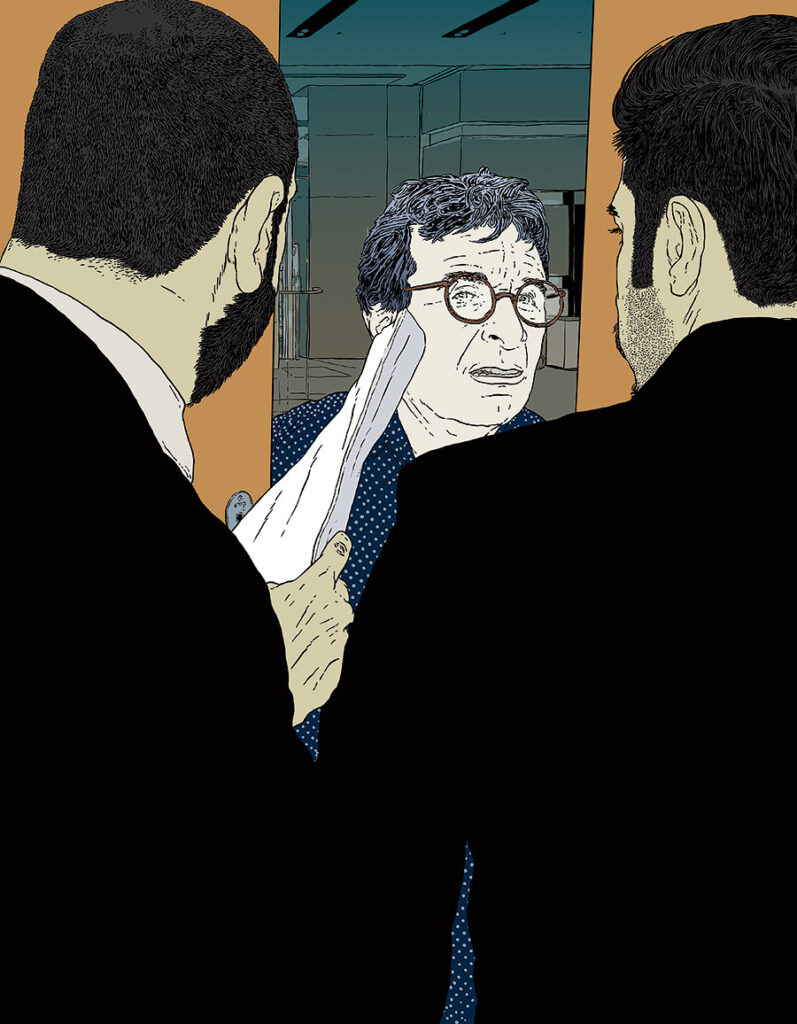
On his first trip to Israel in 1985, Alizadeh avoided having his newly issued American passport stamped by customs officials, asking them to issue him a blue entry slip instead. Because he couldn’t send letters to his parents in Tehran bearing Israeli postage, he arranged a three-way phone conversation with them through a friend living in San Francisco so that it would appear to the Iranian switchboard operator that he was calling from the United States. And when the professors leading the Israeli research team began publishing papers about the project, Alizadeh insisted that they strike his name and photo from them for fear that the Iranian government would somehow get hold of these relatively obscure publications and prevent his return. “I didn’t want to have any records,” he says.
After more than a decade abroad, Alizadeh returned to Iran several times, starting in the early ’90s, and encountered no difficulties. In 1996, the government even approved his proposal to study the patterns of Iran’s nomadic communities, marking the first time a Western-based archaeologist was allowed to conduct research in the country since the Islamic Revolution.
While there, he was careful not to offend the regime, though he would bristle at the strictures of its severe moral code. Well aware that his expeditions were likely to be surveilled by the Ministry of Culture and Islamic Guidance’s so-called morality police (officially known as the Gasht-e Ershad, or Guidance Patrol), Alizadeh firmly warned his staff against any infractions that might jeopardize the projects. Although something of a bohemian in his youth, Alizadeh sounded more like an ardent Islamic fundamentalist when he told his staff there would be no drugs, drinking, or sex during the weekslong digs.
Those warnings were not always heeded. In 2004, while Alizadeh was supervising a major archaeological excavation at Marvdasht, the morality police caught his major-domo having a tryst with a young woman in the encampment. Both were arrested. Summoned to a meeting at the headquarters of the morality police, Alizadeh was admonished for his laxness.
“You should have been more careful,” the police told him.
“Sure, but look, they’re young,” he replied. “Can you just let it go?”
They would not. Alizadeh reluctantly agreed to fire the major-domo, not wanting to jeopardize the project.
Based in part on his fieldwork in Iran, Alizadeh rose to significant positions within the archaeological academic community — he had a stint at Harvard before joining the faculty at the U. of C.’s Institute for the Study of Ancient Cultures (known as the Oriental Institute until 2023) and was awarded several prestigious grants and fellowships. Dedicated to his work, which had him constantly traveling across the world, he did not marry or have children. (“I never met someone that really fit my lifestyle,” he says.)
Some archaeologists in Iran grew jealous of Alizadeh’s success. They also saw him as having unfair access to major sites in their country, a special indignity given the history of 20th-century Western archaeologists smuggling numerous antiquities out of Iran. In the 1930s, ISAC itself, where Alizadeh still works, excavated Persepolis and took many important artifacts back to the United States to be studied and cataloged, including thousands of ancient Elamite tablets. ISAC had permission from the Iranian government, but it still rankled some archaeologists in Iran. Alizadeh got word from friends in Iran that rumors were being spread of his fieldwork in Israel, but he paid it little heed. There was no proof.
In 2006, when the government selected Alizadeh to lead an excavation of the ancient city of Susa in western Iran — a major distinction because he was offered a generous budget and allowed to invite dozens of academics from across the globe to work with him — local archaeologists became incensed. They denounced Alizadeh in the Iranian press, publicly accusing him of maintaining ties with Israel, which significantly raised the pressure on him.
“If somebody becomes your enemy, it’s crazy, but rivalries or jealousies can emerge and one person can really go for the jugular, doing it through the government,” says Emily Teeter, an egyptologist at ISAC and a close friend of Alizadeh’s, who has witnessed similarly bitter internecine fights among archaeologists and other academics in Egypt.
Fearing the negative publicity, Iran ultimately killed the project. When government authorities questioned Alizadeh in person, though, he denied the rumors. “They had no evidence,” he says.
They permitted him to continue researching in Iran, albeit on less high-profile projects. He helped restore the collection of the National Museum, setting up a cataloging system and training the staff in identification techniques, and became friends with the head of the museum in the process. In 2004, Alizadeh had personally ferried Elamite tablets from ISAC’s collection back to Iran; 15 years later, ISAC returned hundreds more. (This came after a 2018 U.S. Supreme Court decision that cleared the way for the tablets’ repatriation, which had been subject to more than a decade of litigation; the American families of victims of a 1997 Hamas terrorist attack at the Ben Yehuda pedestrian mall in Israel had sought to seize the tablets and sell them to recover part of the $71.5 million awarded to them by a federal court.)
During all those visits over all those years, Alizadeh never encountered any problems with the regime that he couldn’t navigate. This time, though, was different.
 pon entering Alizadeh’s apartment, the secret police officers began rifling through his and his brother’s belongings: They examined books, leafed through Alizadeh’s academic papers, pulled apart his bedding, searched under his mattress and pillows, flung open the kitchen drawers, and lifted up the carpets.
pon entering Alizadeh’s apartment, the secret police officers began rifling through his and his brother’s belongings: They examined books, leafed through Alizadeh’s academic papers, pulled apart his bedding, searched under his mattress and pillows, flung open the kitchen drawers, and lifted up the carpets.
“Go sit in the living room,” the lead officer told him and his brother. The others called this man Maytham, though Alizadeh figured it was an alias.
The brothers sat in silence, watching as one officer hooked a device to Alizadeh’s laptop, seemingly hacking into it to download and read his files and emails. They took all his phones, tablets, and computers, as well as his Iranian and American passports.
Surprisingly, they didn’t confiscate his brother’s phone. So Alizadeh instructed him to get in touch with an old friend from his university days and a former student of his, both of whom had risen to high-ranking positions in the Iranian government and might be able to use their influence on his behalf. “When I go, just call these people,” Alizadeh whispered to his brother, anticipating what would happen next. “Tell them that they came and took me.”
The officers escorted Alizadeh downstairs, some in front of him and some in back, and into an unmarked white van with no windows. Alizadeh had heard about these vans: Like the Black Marias of the KGB and the dark green Ford Falcons of Argentina’s military junta, the vehicles used by the regime provoked fear in the Iranian populace.
The officers drove Alizadeh for nearly an hour through teeming streets before coming to a stop in the bustling heart of the city. When they pulled him out of the van and led him into a drab gray building, he was terrified. There had long been whispers among Iranians about a network of secret houses spread like a spider’s web throughout Tehran that the police used for interrogations and torture. The officers took him up three flights of stairs to a nearly empty office. A bearded man was sitting at a long rectangular conference table when they walked in. Maytham and another officer sat down next to the bearded officer, across from where they’d sat Alizadeh.
Alizadeh didn’t bother asking for a lawyer. Few, if any, Iranian attorneys are willing to take espionage cases. For defending an accused spy, they risk being jailed along with their client.
“You’ve told us many times you’ve never been to Israel,” the bearded officer said. “But here it is. We have this proof.”
The interrogator looked smug as he pulled out a copy of Ashkelon I, a monograph known to few outside the small coterie of specialists in Levantine archaeology. Based on more than a decade of fieldwork at an excavation site near the coastal Israeli city of Ashkelon, the book documented in stark black-and-white images that Alizadeh had visited Israel every year from 1985 to 1991, contrary to his past disavowals.
I’m finished, Alizadeh thought. But how did they get that?
He immediately suspected a rival Iranian archaeologist. No one else could have sent them a copy, he thought. The publication was too obscure.
Alizadeh nervously sipped the cup of water set in front of him, but his mouth was so dry that it barely slaked his thirst.
Like something out of a police procedural, his interrogators seemed to be playing a good-cop, bad-cop routine.
“Don’t lie. We know that you archaeologists are a godless lot,” one of them said. “You’re a worm, a dog, a filthy donkey.”
Maytham, however, treated Alizadeh with deference, calling him “doctor” and suggesting that it wasn’t totally Alizadeh’s fault for going to Israel. Perhaps he was just young and naive.
Alizadeh poured another cup of water. His hand quivered as he drank.
“All right, yes, I went there,” he admitted, not wanting to risk contradicting them and receiving a beating in return. He knew that he would break under torture, so he might as well confess before they harmed him.
They asked him about the articles that Iranian archaeology students sent him for review, which included maps, as do many archaeological publications, showing the exact locations of Iranian digs and the distances between them. They accused him of providing these detailed maps to Western intelligence agencies.
“So you are collaborating with your Iranian spies to get this information. To whom in America and Israel do you give these maps?” they asked.
“Go to Google, they’re full of these maps, they’re all over the place,” Alizadeh responded. “There’s nothing special about these maps.”
Another interrogator asked about his email correspondence with Steven Rosen, an esteemed Israeli archaeologist at Ben-Gurion University who studies ancient Bedouin nomads.
“Do you know who Rosen is?” he asked.
“Yes, he’s an archaeologist,” Alizadeh replied.
“No, he’s in Mossad,” he said, referring to Israel’s intelligence agency. “And you are in contact with him.”
“I really don’t know if he’s in Mossad. You have better information. But you can see the emails. All we are doing is archaeology.”
“Well, you deleted those that are not archaeological.”
“If I wanted to do that, I would delete these too so that you wouldn’t see, no?”
(When contacted by Chicago by email, Rosen responded: “I do not and never have worked for the Mossad in any capacity, either for pay or voluntarily. The accusation is pure absurdity.”)
Alizadeh felt frustrated by their questions — anyone with a bit of knowledge about his profession would have understood that these maps were nothing unusual — but his interrogators were insistent that he was hiding a more nefarious truth. The usually unflappable professor tried to cool his growing temper, answering everything as politely as possible. He knew that if he challenged the officers too much, they might start hitting him.
The interrogation dragged on like that for several hours. Alizadeh remained on edge the entire time, unsure when or how it would end. When it finally did, they had him sign, line by line, page by page, a transcript of his testimony. That tedious process took more than an hour. He was sure that he would then be taken to the courthouse, where a judge would give the charges against him a perfunctory look, see his sworn statement admitting he had traveled to Israel, and send him packing to the notorious Evin Prison, in northern Tehran, where he would await his inevitable execution. (According to Amnesty International, in the two years following Alizadeh’s arrest, the Islamic Republic of Iran has executed more than 850 people, mostly for drug-related offenses but some on claims of espionage, including a prominent British Iranian accused of spying for MI6.)
But like Fyodor Dostoyevsky looking down the rifle barrels of the tsar’s death squad over a century before, Alizadeh had yet more time. The officers told him he was being placed under house arrest. They said they would check in on him periodically, calling his apartment to make sure he was at home and stopping by on occasion to visit. Alizadeh was sure someone must have intervened on his behalf.
Back in the unmarked white van, Alizadeh was driven through the traffic-clogged streets of Tehran. The van pulled up in front of his apartment, and the officers escorted him to his door and left. Alizadeh watched as the van sped off into the evening.
 houghts raced through Alizadeh’s mind. If they weren’t going to throw him in prison or execute him, why were Iranian authorities using these spurious accusations as an excuse to place him under house arrest? The only thing he could figure was that they were hoping to hold him in Iran in exchange for money.
houghts raced through Alizadeh’s mind. If they weren’t going to throw him in prison or execute him, why were Iranian authorities using these spurious accusations as an excuse to place him under house arrest? The only thing he could figure was that they were hoping to hold him in Iran in exchange for money.
History offers some evidence to support this thinking. Since 1979, Iran has taken nearly a hundred Americans hostage. In 2015, the country signed a landmark agreement in which it promised to halt its nuclear weapons program in exchange for $100 billion in sanctions relief from the United States and Europe. Also figuring into the deal: a hostages-for-prisoners swap. After the Trump administration abruptly reinstated onerous sanctions against Iran in 2018 for supposed violations of the agreement, the country went into an economic tailspin, prompting massive anti-government protests and a subsequent crackdown on dissent.
Alizadeh began to mull how much the regime would want for him and what, if anything, he could offer in exchange for his freedom. He borrowed his brother’s cellphone (his had never been returned) to fire off a WhatsApp message to Teeter, filling his friend in on his detainment but pleading with her not to tell anyone else because it might cause a stir.
Teeter was terrified for Alizadeh. She worried that the next time the secret police showed up at his apartment, they would haul him off to prison and that would be the last anyone would hear from him. So she betrayed his trust and asked Theo van den Hout, the director of ISAC at the time, for help. “It had to go to the people at the top of the chain because this was just getting way too dangerous,” she says.
Van den Hout, an academic from the Netherlands, had no experience with hostage negotiations, so he reached out to the U.S. State Department. Officials there sent him forms for Alizadeh to sign, granting them permission to publicize his likeness and a brief biography should the situation worsen and a public pressure campaign become the option of last resort to stave off an execution.
Van den Hout also contacted the head of the National Museum of Iran, threatening that if Alizadeh didn’t return to the United States safely, Iran would never see the 25,000 Elamite tablets that ISAC still had in its possession. Alizadeh reached out to a former student who was well connected with the Iranian government, claiming that the tablets were worth billions of dollars, a fib designed to entice authorities.
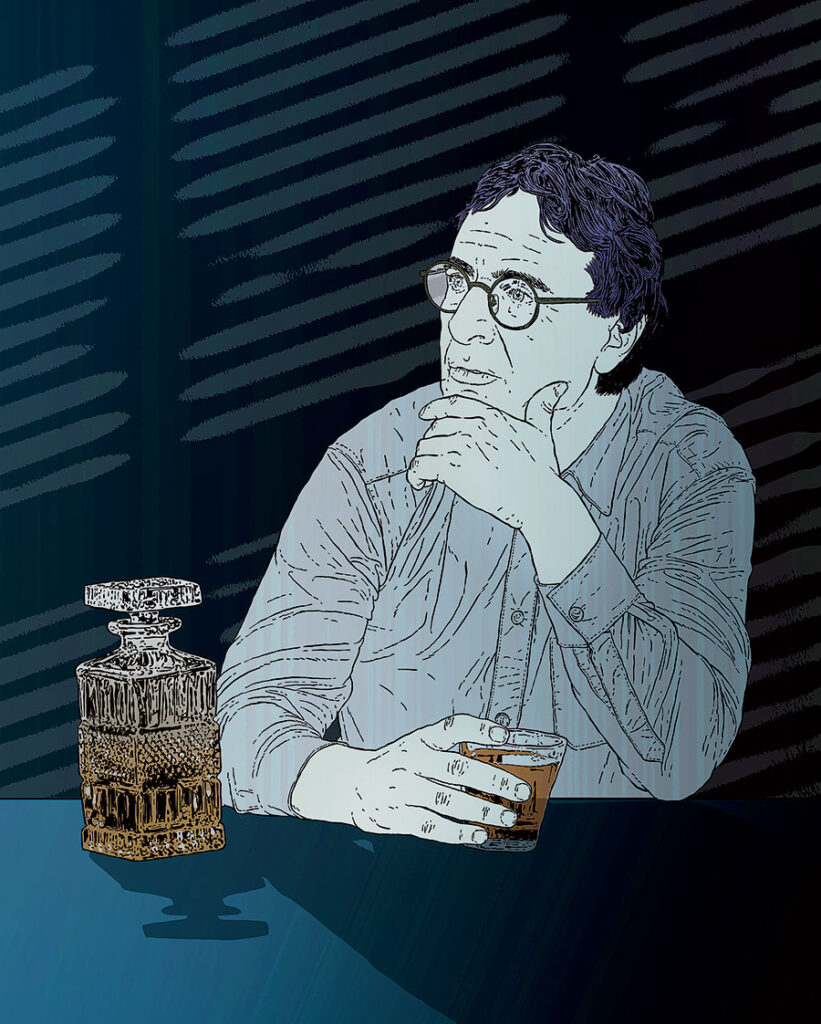
Days passed under house arrest. Then weeks. Then months. Over time, Alizadeh grew less confident in his plan of using the tablets as leverage to secure his release. Tormented by thoughts of unending detention or a grisly death, he sank into a severe depression. Without his laptop, he couldn’t work, not that he had much desire to. He sat around during the day, watching Turkish soap operas and international news channels. At night, he either drank heavily from his stash of illegal whiskey or took enough sleeping pills to fall into a stupor. He would wake the next morning feeling foggy and desultory. He ate little, losing 10 pounds from his already slight frame.
Every couple of weeks, the secret police arrived again at his building to take him to another undisclosed location and interrogate him for at least four hours. They always asked the same questions: Why was he in Israel? Who was his contact in Mossad? Who were his fellow spies in Iran? Alizadeh would patiently offer the same explanations: He was only an archaeologist, and anyone he corresponded with or any organization he worked with in Israel was purely for research. He assumed the police were trying to get him to make a mistake, to contradict himself. But he kept repeating what he knew to be the truth.
By August, three months into his house arrest, Alizadeh sensed his interrogators losing patience with him — their language had grown coarser, more hostile. And no longer did they allow him to answer their queries face to face. Instead, they sat him in front of a blank wall and peppered him from behind with questions about the same tired subjects and details they had gone over many times before.
Figuring the punishment for fleeing could be no worse than for espionage, he devised a daring plan to escape the country. In Iran, those traveling by airplane, train, or bus must show a national ID card or a valid passport. But Alizadeh’s passports had been confiscated, and even if he still had them, he was certain he was on a travel watch list.
One day while on a brief walk near his apartment, Alizadeh took a risk — maybe he was under surveillance — and flagged down a private taxi. He asked the driver if at some point in the near future he would drive him, on a moment’s notice, the 1,300 kilometers (roughly 800 miles) from Tehran to Bandar Abbas, a port city on the Persian Gulf. He could pay 150 million rials (about $3,500), more than a typical year’s earnings for a cabby. The man agreed.
The trip would take two days. Staying in a hotel required identification Alizadeh didn’t have, so he said they would camp along the route and that he had sleeping bags for them. He took down the man’s phone number and told him to await his call.
What Alizadeh didn’t tell the cabby was that he’d already contacted a fisherman in Bandar Abbas who specialized in smuggling Iranians across the Persian Gulf, past patrols of armed Revolutionary Guards in speedboats, to the United Arab Emirates or Qatar. It was a perilous scheme, but Alizadeh thought it was his best shot at freedom.
In the days before his planned escape, Alizadeh grew nervous. He couldn’t help thinking of all the possible ways it could go wrong: The taxi might break down on an unpaved section of road. He might be questioned by the police for sleeping outdoors and asked for identification.
Then out of the blue one morning in mid-August, the phone rang. It was a secret police agent. He told Alizadeh to come pick up his belongings, including his passports.
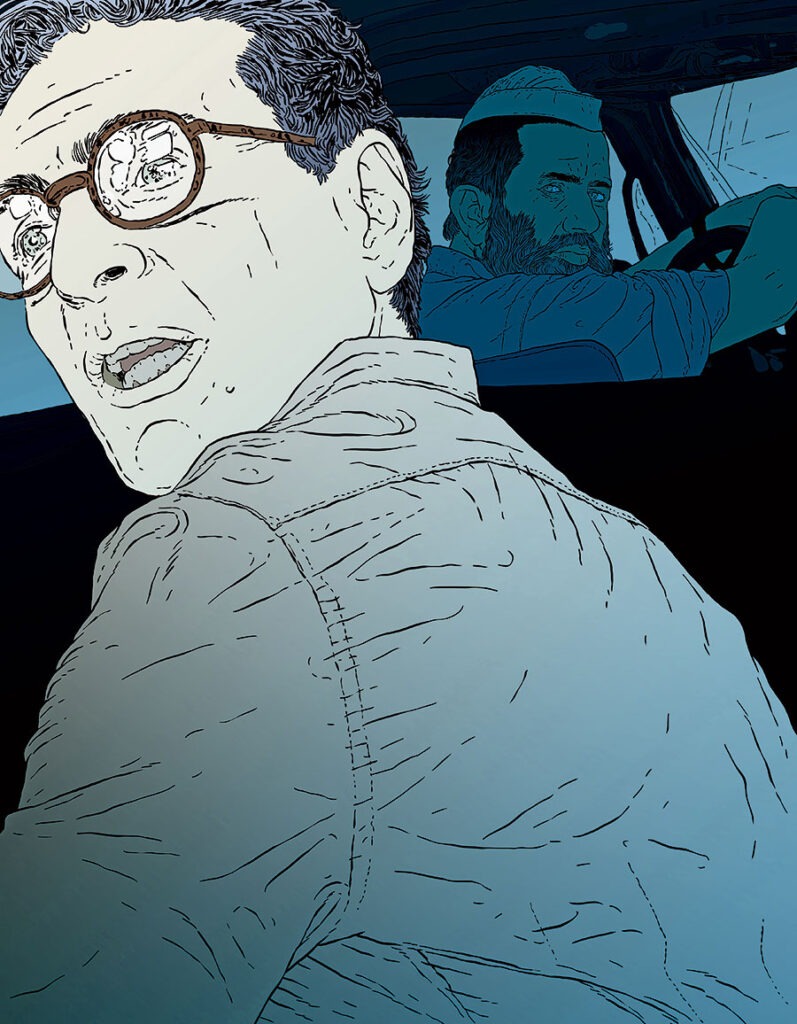
The professor was stunned. His audacious escape plan might not be necessary after all. Relief washed over him.
Alizadeh rode the subway to the appointed location, an office building downtown. He was told he was no longer under house arrest and was free to leave the country. He was so happy that he sat beaming for two full hours while Maytham, the secret police officer who had been at his first interrogation in May, gave him a final lecture.
“We know that you didn’t intentionally do any harm to the Islamic Republic, but you have to be very careful,” Maytham told Alizadeh. “The enemy [Israel] always takes advantage of what you say and do, even though you think it’s harmless.”
Maytham went on and on in this manner, also urging Alizadeh to be a good Muslim by professing his faith in Islam and Allah. Alizadeh politely agreed with everything Maytham said, until he was finally allowed to collect his things and go.
Back at his apartment, Alizadeh asked Van den Hout to book him the next available flight to Chicago. Three days later, on August 19, Alizadeh arrived at Imam Khomeini International Airport six hours before his flight because he was so anxious to get out of the country. His brother dropped him off, and Alizadeh knew it would likely be the last time he’d ever see him. It would be too dangerous to risk coming back. But he couldn’t bring himself to say that to his brother. “I think everything is fine now,” Alizadeh told him instead. “So I can travel, but maybe not for a couple of years.”
In the airport lounge, he scarfed down a plate of sambuseh and several halal hot dogs. As he waited, he couldn’t help worrying that the Iranian government would change its mind before he got out. He paced around the terminal, browsing in stores without the merest inclination of buying; he needed the distraction. All that time, he felt his stomach churning like a washing machine.
He boarded the Austrian Airlines plane. The jet bridge door closed. The flight attendants went through their safety drills. The plane took off.
It was only when they reached cruising altitude that unalloyed joy washed over him, a feeling unlike anything he had ever experienced before. As soon as they were out of Iranian airspace, he ordered a Scotch. After months of drowning his sorrows in drink, he sipped this one with pure pleasure instead.
The plane touched down in the early afternoon on August 20 at O’Hare. Alizadeh dropped his bags off at his Hyde Park apartment and then headed to Medici on 57th for pizza and beer.
He needed time to compose himself before seeing people, so Alizadeh didn’t meet up with Teeter until a few days later. She wrapped her old friend in an enormous hug, shedding tears of relief that he was finally safe. “I didn’t believe it until I saw him,” she said.
After a week, Alizadeh returned to his second-floor corner office at ISAC, which is housed in an art deco building on the University of Chicago campus. He got back to work as if nothing in his life had changed, although so much had.
One afternoon this past October, Alizadeh is sitting at his desk at ISAC, surrounded by piles of papers, maps, and books. An unflattering political cartoon of Iran’s Supreme Leader is pasted to a wall. More than two years have passed since his detainment. Were it not for the tranche of age-old tablets, he thinks he would be languishing in a prison cell in Tehran.
He is certain the tablets are the only reason the Iranian government agreed to free him, although its leaders would never formally acknowledge that. Indeed, last summer, ISAC resumed shipments of them back to Iran through the country’s office at the United Nations in New York City, as Iran does not maintain a formal embassy here. “Who would ever know that some little scribes 2,500 years ago in Persepolis were writing my ticket to freedom?” Alizadeh says. “It’s just incredible.”
Surviving the harrowing experience, he says, gave him a new lease on life. “I feel much younger,” says the gray-haired professor, whose crow’s-feet emerge from behind owlish glasses. “I feel happier. Before it was just the same old stuff, but now, even when I write academic stuff, I do it with joy. Every morning I wake up is such a wonderful day. It’s not boring anymore for me.”
Instead of retiring after his ordeal, Alizadeh has remained dedicated to shedding new light on Iran’s prehistoric past. He is hard at work on a report about the subsistence strategies and social differentiation of the ancient peoples who lived in encampments near modern-day Shiraz.
But he isn’t planning to return to Iran — at least as long as the Islamic Republic’s authoritarian regime remains in power. He doesn’t conceal the anger he feels toward the government. The cruelest irony, he says, raising his hands indignantly, is that he has done so much for his country, and yet it accused him of committing treasonous acts.
“Abbas pretty much stood over the rebirth of archaeology as a discipline in Iran,” says Teeter. “Iran really owes him a tremendous credit, which is why this whole thing was so ridiculous and so frightening.”
To share his culture with a wider audience, Alizadeh is hosting a series of screenings of documentary and feature films set in Iran. Some were made by currently incarcerated Iranian directors like Jafar Panahi. Showcasing their work is one small way to thumb his nose at the regime.
The only mementos he keeps in his office from his homeland are four dried-up balls of clay — soil samples he took from various regions in Iran. Years ago, he imported them into the United States so he could determine the geographic origins of some potsherds in ISAC’s collection by comparing their mineral contents against those of the clay.
“God created man from clay,” he says, alluding to ancient tradition, and picking up one of the balls and rolling it between his palms. Despite the mental wounds wrought by his final visit to Iran, there is at least this piece of home he is still holding on to.



